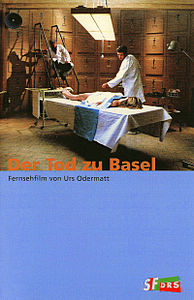Death in Basel
| Movie | |
|---|---|
| Original title | Death in Basel |
| Country of production | Switzerland , Germany |
| original language | German |
| Publishing year | 1992 |
| length | 70 minutes |
| Rod | |
| Director | Urs Odermatt |
| script | Markus Kutter based on an idea by André Ratti |
| music | Christoph Marthaler |
| camera | Reinhard Schatzmann |
| cut | Dominique Beinroth |
| occupation | |
| |
The death of Basel is a feature film by Urs Odermatt from 1992. The television film was based on a script by Markus Kutter and an idea by the Swiss television journalist André Ratti .
action
In Basel is puzzling deaths occur: people die out of the blue in public with no apparent cause of death. The coroner, Professor Rüegg from the pathology department, the cantonal doctor Zäslin and the politicians are at a loss and are faced with fear - the press is exploiting the scandal. It is even - a sensation for Basel - seriously considered not to let the upcoming Carnival take place.
Rüegg's assistant Andreas Zinstag, who also has to deal with the deaths, lives with his uncle, Jean-Jacques Zinstag, a retired doctor. This begins to be interested in the mysterious deaths. In the circle of his friends - scientists, artists, journalists - Zinstag developed the theory that people do not die of a certain illness, but "of death". The Grim Reaper himself is moving into Basel, just like in the dance of death.
Zinstag determines that the apparently unrelated deaths are linked by a law. On the city map of Basel, Zinstag traces the spiral of death from one victim to another and can finally predict that death is approaching his house.
For Zintag's nephew Andreas and the nurse Gabi, who have only just begun their medical careers, confronting the mysterious deaths becomes a touchstone. Should they follow in the footsteps of Andreas' boss and Gabi's lover Rüegg, who, like his patients in general, regards deaths as exclusively clinical problems? Or should they, like the old interest day, also create space in their worldview for other, non-medical factors? For its part, Zinstag recognizes that the new dance of death in Basel can only be put to an end if everyone does not let death grab them and pull them away, but instead someone turns the tables.
background

André Ratti, a Swiss journalist, had the idea for the film. With her he went to Markus Kutter , who was supposed to write the script. Kutter agreed and Swiss television soon showed interest. Ratti suddenly fell ill with AIDS and died in 1986. The film seemed to have become impossible.
A few years later, Kutter discovered a new dimension in the subject: A media man is designing a film about death in Basel and his story itself catches up with him. The dance of death city , today's healthcare system, the lifestyle of old Basel, the modern media and a character named André can be found in a film that has become a film about that film. Kutter built the character into the story who is now the central character of the film. A filmmaker who makes a film whose story is about a mysterious death that doctors and authorities cannot explain. This filmmaker, suffering from AIDS, makes his own death public, as André Ratti himself did.
The death in Basel was produced in 1990 by Swiss television together with Westdeutscher Rundfunk. The first performance was on January 26, 1992 on Swiss television SF 1 .
Reviews
"A mixture of fable, thriller and drama permeated with bizarre and grotesque features."
“The story is not a fairy tale, it is rather copied from life and death, it is multi-layered, mystical and wonderfully untimely. A beacon from the depressive lowlands of the Upper Rhine Plain, but free from tranquility and psycho-poison, thanks to the (German) actors of new Swiss quality and without false slowness. "
“One [is] at times [...] confronted with scenic moments in which a hint of mere foolishness can be felt. The theme, however, determines the gloom of the atmosphere, which is stylistically persistent thanks to a lot of night darkness. The form of the dance, created around the central figure of the filmmaker and his work on the assembly table, can be felt. But it is always lifted because it is not death that determines the tour, even if it is personified, as a nobleman with a black hooded appearance. It is this break that creates two levels, which at times is counter to attention. But it is banned by the demands made by the actors, especially Günter Lamprecht in the role of the filmmaker. Here the film gains an intensity that it otherwise does not have consistently in terms of image and montage. "
Web links
- Death to Basel in the Internet Movie Database (English)
- Death in Basel - Official Website
Individual evidence
- ^ The death of Basel at filmportal.de , accessed on February 21, 2012
- ↑ Evaluation , accessed on February 21, 2012
- ↑ Death in Basel in the Lexicon of International Films , accessed on February 21, 2012
- ^ Morpheus: Without Tranigkeit and Psychomuff, Die Weltwoche , January 30, 1992
- ↑ Martin Schlappner: View of the screen - The death of Basel , Neue Zürcher Zeitung , January 28, 1992


